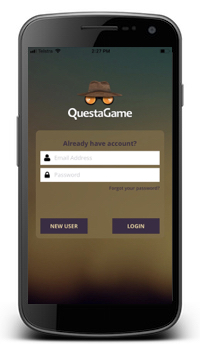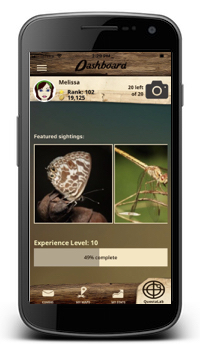Creating a New Generation of Ecologists
QuestaGame for Schools has been developed for teachers to encourage students to explore nature, learn about biodiversity, and contribute to science at the same time.
About QuestaGame
QuestaGame has thousands of experts who help players identify and learn about the species they find. These experts include leading scientists from some of the world’s most prestigious scientific institutions, such as renowned museums and universities. They also include amateur field naturalists, be they retired biologists, students, or hobbyists who can identify thousands of species.
But here’s the thing:
Some of the top performing experts on QuestaGame - the ones who can quickly and accurately identify the most species - are amateurs.
And here’s the really remarkable thing:
Some of these top performing experts are less than 15 years old.
The fact is, if given a chance, most young students will excel at identifying wildlife. They are just as capable of contributing to our scientific knowledge about biodiversity as anyone else.
STEPS TO GET STARTED
1. Register your class (team). Your team “owner” account should already be registered on QuestaGame BEFORE you register your class. Each team supports 25 students. If you have more students in your class, you can regis\ter multiple teams.
2. Once your team is registered, students should create their accounts on QuestaGame. They then go to the QuestaGame for Schools BioQuest page at http://questagame.com/schools. They select their team and get started.
3. You can monitor your class’s activity, and communicate with the class, at http://portal.questagame.com
BIODIVERSITY IS ABOUT EVERYONE
It turns out that biodiversity is way too vast and fascinating for professional scientists to understand it all by themselves.
In fact, if we’re going to figure out how best to coexist with nature, it’s going to require millions of people - maybe hundreds of million of people, maybe more than 50% of all humanity - to closely observe and learn about their natural environments.
NATURE IS BORING!
If we teach students about nature from inside a classroom, yes, for some students it may seem boring. See that cage over there? That aquarium? That jar? That poster with the lion? That ranger holding a terrified rabbit? That’s nature for you. That’s biology. Now open your textbooks to page 58.
But what happens when we get outdoors and get students competing to find and identify as many species as they can?
Luckily, it also turns out that our brains are predisposed to do exactly this. Nature astonishes, captivates, delights. Sometimes, sure, it terrifies us too. But it always thrills us. It always grabs our attention. Few if any fictional works of fantasy - be they books, movies, online games - can compare in sheer entertainment value to a real encounter with real wildlife.
Finally, perhaps most importantly, spending time in nature not only stirs our curiosity, but it’s good for our health. It increases mental well being. It helps us heal. It strengthens our communities. Indeed, our biology yearns to be outdoors.
For more information about the health benefits of nature, read this independent review of over 200 scientific journal articles - http://parkweb.vic.gov.au/about-us/healthy-parks-healthy-people/the-research
STEP 1 - GET OUTDOORS!
If possible, take the class outside. Stand near organic life. Trees. A field or patch of grass. What is life? What does it mean to be alive? Can the students see life? Hear life? Smell life? What’s an organism? What distinguishes one organism from another? What’s the difference between a plant and an animal? An spider and a frog? Why are they different? How and why do we classify living things?
Ask the students to make a list of all the different life forms that exist around them. Explain that these lists represent the biodiversity of that location. Discuss biodiversity.
STEP 2 - EXPLORE BIODIVERSITY
Explain to the students that people have created collections of living organisms for thousands of years. Sometimes in zoos. Sometimes in museums. It could be insects pinned and stored in drawers, or small mammals preserved in jars. It could be photographs in books. Recently people have been using digital technology to turn these collections into detailed maps of biodiversity. Show them some maps on the Global Biodiversity Information Facility (http://www.gbif.org).
Digital technology allows the photos you take to be tagged with a precise location. Explain to the students that they’ll be using the camera in the QuestaGame app to create their own collection of living organisms. Explain that they want to collect as many different types of organisms as they can, and that their collection will help researches better understand and protect the environment. This type of activity is sometimes called ‘citizen science.’
STEP 3 - LET THE FUN COMMENCE
Prepare the technology (Estimate: 25 minutes)
Login page
Dashboard (main landing page).
Take a photo!
The closer the better
Make sure you have an account on the QuestaGame app. If you don’t have an account, you can download the app from iTunes or the Google Play Store. Alternatively, you can register an account here.
Install QuestaGame from iTunes or the Google Play Store onto mobile devices for the kids.
Create accounts for your students on QuestaGame - or let your students do it. Note: The names you create should not be real names, and the email addresses do not need to be real, but they must be unique.
The students can join your team(s) at http://questagame.com/schools.
IMPORTANT: SAFETY CHECK. Be sure to read and discuss QuestaGame's safety guidelines.
IMPORTANT GOOFY CHECK: Mobile devices are cool. Cameras are fun to play with. It's natural for students to want to experiment with them - to start taking selfies, a cheeky photo of someone's foot. No worries, depending on your setup, you'll likely need to approve any incoming sightings from the students anyway. Newly submitted sightings will appear at http://portal.questagame.com/rangervision
Important things to know
Students use QuestaGame to submit ‘sightings,’ which are photographic observations of a species.
Students should only submit one species at a time.
Students should not submit sightings of domesticated animals, humans, or cultivated plants.
Students can submit up to 5 photos of a ‘specimen’ per sighting.
What’s a specimen? A specimen is a living example of a single species.Students can add ‘field notes’ describing the sighting.
What are field notes? Field notes are observations about the specimen. For example, what was the specimen doing? What other living things did you see around? What is the weather like? And so forth.
IMPORTANT: Newly submitted sightings will appear at http://portal.questagame.com.
Students can submit up to 5 photos of a ‘specimen’ per sighting.
Step 4 - CLASSIFY, COMPARE, ASSESS WHAT YOU'VE FOUND!
Categorise and try IDing your sightings (Estimate: 25 minutes)
Students can use the “Laboratory” feature in QuestaGame to categorise their sightings and identify other player’s sightings, or you can login to portal.questagame.com and review the sightings together as a class.
After some time - usually within 24-48 hours - they will receive identifications from experts, which they can see in the app > Dashboard > Messages.
So the students now have a collection of their sightings.
Once their sightings are identified, they will appear in the Atlas of Living Australia within two weeks.










